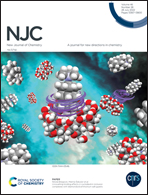Tuning the electronic, magnetic, and sensing properties of a single atom embedded microporous C3N6 monolayer towards XO2 (X = C, N, S) gases†
Abstract
Two-dimensional frameworks have attracted significant attention due to their great potential in many applications. Among the g-CxNy family, C3N6 is one of the recently synthesized promising candidates, which exhibits semiconducting behavior. Motivated by its potential, we performed first-principles density functional theory (DFT) calculations to explore the structural, electronic, magnetic, and gas sensing properties of the C3N6 ML towards common pollutants, such as XO2 (X = C, N, and S). We found weak binding between the pristine C3N6 ML and XO2, which was not suitable for efficient gas capture. However, functionalization with a selected transition metal not only altered the electronic and magnetic properties but also improved the sensing behavior of TM–C3N6 (TM = Sc, Ti, V, Cr, Mn, Fe, Co, Ni, Cu, and Zn). We have analyzed the adsorption behavior, desorption time, and correlation matrix of TM embedded C3N6 towards XO2 (X = C, N, and S) gases. Electronic structures and magnetic moments of XO2 adsorbed TM–C3N6 depend on the atomic number of the embedded TM atom and the adsorbed gas molecules. We found that the adsorption energies of TM–C3N6 systems towards NO2 gas molecules are stronger in comparison to CO2 and SO2 gas molecules, which suggested a selective capture mechanism. Based on our findings, TM–C3N6 systems turned out to be promising adsorbent materials for environmentally toxic pollutants.



 Please wait while we load your content...
Please wait while we load your content...